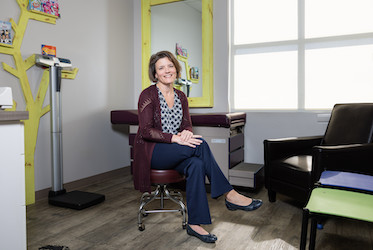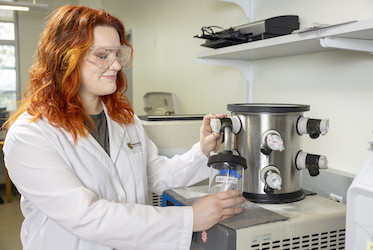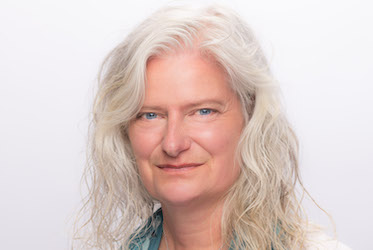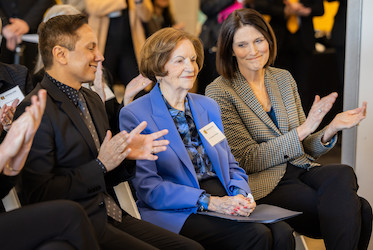
National Science Foundation awards grant for limb development, birth defects research
KENNESAW, Ga. | Feb 14, 2017
Developmental biologist Marcus C. Davis demonstrates common genes form fish fins, human hands

The National Science Foundation (NSF) has awarded $358,803 to Kennesaw State University developmental biologist Marcus C. Davis for research that ultimately could lead to eradicating limb birth defects and allowing humans to regrow limbs.
“Professor Davis’ work represents the best of scientific research,” said Mark Anderson, dean of the College of Science and Mathematics. “His projects span multiple disciplines and engage methods typically used in molecular and cellular biology to areas as diverse as evolution, anthropology, genetics and medicine. This is a great example of the transdisciplinary approach to scientific research that faculty members are creating in the College of Science and Mathematics and that the faculty are bringing into the student experience.”
The basis of Davis’ hypothesis is that despite their anatomical differences, fish fins and human hands and feet share the same basic genetic instructions for building their skeletons.
For years, scientists had thought otherwise. Since the ways in which fins and limb skeletons formed were different, they argued, the genes that regulate their formation had to be different, as well.
“The fins of fishes and the limbs of terrestrial vertebrates, or tetrapods, are anatomically distinct: Fins are ‘capped’ in a series of rays, while our limbs end in an autopod – we call them hands and feet,” Davis explained. “Importantly, fin ray formation doesn’t involve the development of cartilage, which is a critical component of limb formation. Together, these differences supported the prevailing view that fin rays and autopods are patterned by distinctly separate genes and genetic ‘circuits.’”
According to Davis, associate dean for research and associate professor of biology, data from his lab show that the same genetic circuits form the distinct skeletons of both fin rays and autopods.
“I think the implications for birth defects research and regenerative medicine are significant here,” Davis said. “Fin rays now become a much more informative model for understanding birth defects in human hands and feet, because fin rays are using the same gene circuits but are easier and relatively cheap to study compared to alternatives such as mice.
“Additionally, fin rays can regenerate after damage or disease,” said Davis. “Our hands and feet don’t have this capacity. Perhaps unlocking the secrets of limb regeneration will involve just a few small therapeutic adjustments to this shared genetic circuit.”
In order to test their hypotheses, Davis and his research team study gene activity in embryos of two “living fossil” fish ideally suited to address these questions, the American paddlefish and the small spotted catshark.
“Much of our current focus involves experimentally testing the role these genes play in patterning the fin skeletons in our fish and then comparing our insights to existing mouse genetics and human clinical research, such as birth defects studies,” Davis explained.
“They also explain common forms of congenital birth defects seen in human hands and feet,” Davis said. “As we move forward, we expect our experiments to demonstrate that a shared genetic program regulates the formation of fin rays and hands and feet. The developmental basis of the fin-to-limb transition remains a longstanding question in evolutionary biology.”
Under terms of the NSF grant, Davis will train a diverse group of graduate and undergraduate researchers who will be involved in all aspects of the project, including experimental design, microscopy, publication of results and outreach activities such as hosting virtual access to the Davis lab and collaborating with Davis in visits to metro Atlanta public schools.
Donald McGarey, interim chair of the Department of Molecular and Cellular Biology and professor of biology, explained that besides the high impact potential of Davis' research, his lab has been a productive training ground for many KSU biology majors who have made the leap to graduate and professional programs around the country. Funding from the NSF will allow Davis to continue to be highly productive as a scientist and as a mentor to students.
"New discoveries often result in challenging and revising established paradigms and Marcus Davis' research in limb development is doing just that," McGarey said. "The 'Davis Lab' (a collaborative group of post-docs, undergrad and graduate students, research faculty and an energetic Marcus Davis) is defining a new regulatory model for normal limb development and what happens when these regulators behave abnormally. The work being performed in the Davis Lab seeks to divulge conserved evolutionary processes driving limb patterning and development in various vertebrate animals, and by understanding these mechanisms be able to translate it to medical applications such as predicting limb defects, and perhaps how to regenerate lost limbs."
Robert S. Godlewski
Photos: David Caselli
Related Stories

Kennesaw State researcher applies mathematical modeling expertise to health care systems

From the salon to the lab, chemistry student shines at Kennesaw State

Academic leader, researcher named dean of Kennesaw State's College of Science and Mathematics

Kennesaw State Academic Learning Center named for longtime family benefactors
A leader in innovative teaching and learning, Kennesaw State University offers undergraduate, graduate and doctoral degrees to its more than 45,000 students. Kennesaw State is a member of the University System of Georgia with 11 academic colleges. The university’s vibrant campus culture, diverse population, strong global ties and entrepreneurial spirit draw students from throughout the country and the world. Kennesaw State is a Carnegie-designated doctoral research institution (R2), placing it among an elite group of only 7 percent of U.S. colleges and universities with an R1 or R2 status. For more information, visit kennesaw.edu.














